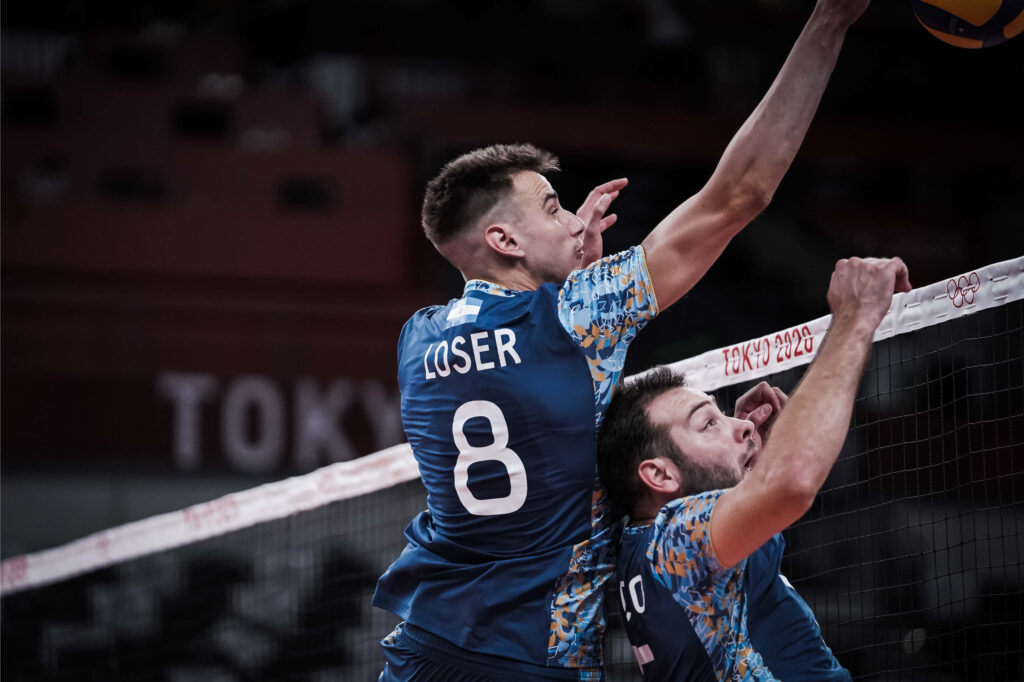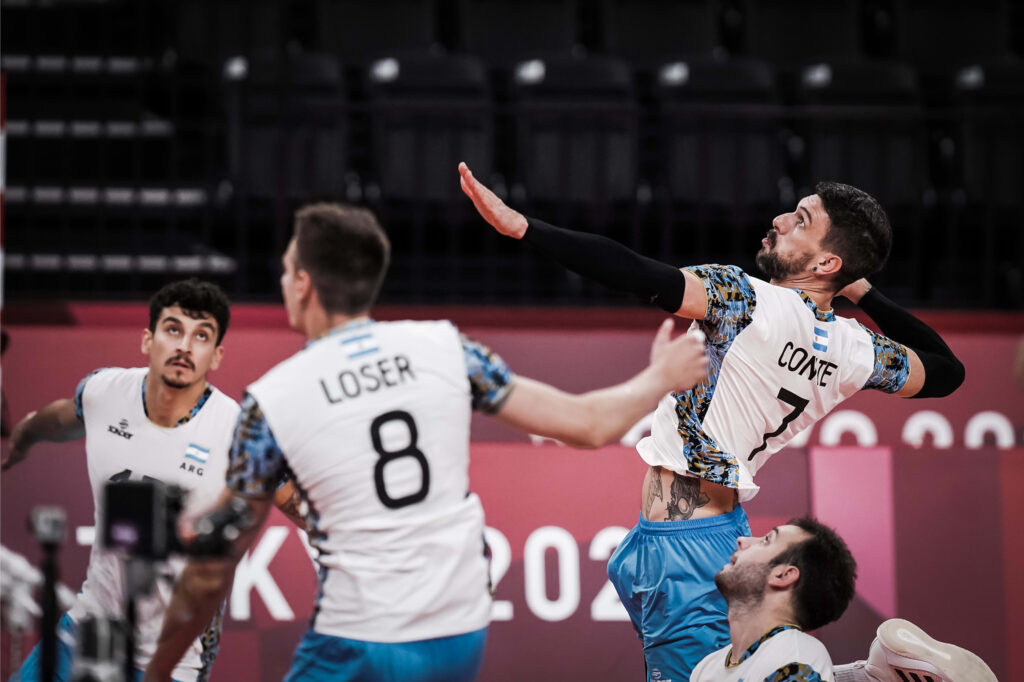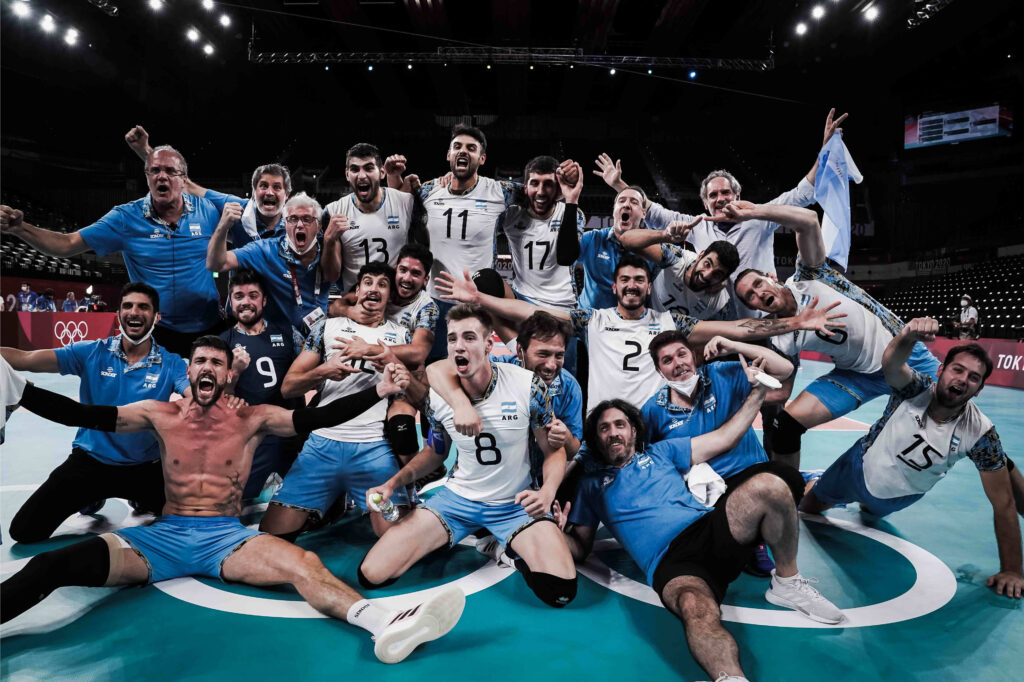Times have changed. In the Tokyo Olympics men's volleyball third-place playoff, Argentina, ranked 6th in the world, defeated Brazil, ranked 1st in the world and the previous champion, 3:2 (25-23, 20-25, 20-25, 25-17, 15-13) to win the bronze medal. Conversely, Brazil missed out on an Olympic medal for the first time in five tournaments since the 2000 Sydney Olympics. How did Argentina, which is inferior in height and player quality, defeat the champion Brazil? If we understand this, I think we can see the future direction of the Japanese national team, which is also inferior in height to the world. So this time, I will explain the key points of that victory!
In conclusion,Thorough implementation of the norms of modern volleyballwas a major factor in Argentina's victory. So what was that obvious thing? This time, I will explain it in four main points.
Starting lineup and height of each team
Before we get into the game commentary, let's review the starting lineups and heights of both teams.
Argentina
Outside hitters (OH): 7 Conte (197cm), 13 Palacios (198cm)
Middle blocker (MB): 9 Rosell (193cm), 11 Sole (200cm)
Opposite (OP): 12 Lima (198cm)
Setter: 15 Dececco (191cm)
Libero: 9 Danani (176cm)
Average height (non-libero): 196.1cm
Brazil
Outside hitters (OH): 9 Real (202cm), 18 Lucarelli (196cm)
Middle blocker (MB): 13 Souza (209cm), 16 Lucas (209cm)
Opposite (OP): 8 Wallace (198cm)
Setter: 1 Bruno (190cm)
Libero: 17 Tarres (190cm)
Average height (non-libero): 200.6cm
Brazil's average height is only 4.5cm taller, but if we look at just the middle players, there is an average difference of over 10cm. It seems fair to say that Brazil had the advantage in terms of block height. Also, while all of Brazil's starters play for top clubs in Brazil or Italy, nearly half of Argentina's players play in the French league, which is by no means at the top level. It's fair to say that Brazil also has more experience as an individual player.
Next, we will explain the reasons why Argentina, a team inferior in both physique and experience, won.
① Don't serve to the libero
Argentina was thorough in not allowing the libero of the opposing team to receive the serve. If the libero receives the serve, not only will the serve return rate increase, but the other four spikers will be able to get a good run-up and launch an attack, making it difficult for the defense to narrow down their attack, putting them in an even more disadvantageous situation. Therefore, the golden rule for serves is not to aim at the libero.
Argentina had a serving lineup with four jump servers, one jump floater and one hybrid serve, but apart from OH Conte and OP Lima, the jump servers hit slightly slower control serves, and were thorough in serving to keep the libero from touching them, rather than serving as an ace. It also seemed that Conte and Lima hit control serves rather than power serves about half the time. However, there were still cases where the serve was touched due to poor control or the opposing libero, Tarres, covering well, and Brazil actually took the sets where this happened a lot. In the first, fourth and fifth sets that Argentina won, the Brazilian libero's reception rate was 11.7% of all serve receives, while in the second and third sets won by Brazil, Tarres took 29.01 TP3T serves.
Not letting the libero do his or her job in this serve reception is more important than lowering the opponent's overall success rate in receiving serves. This is because reducing the number of attacks by the opponent or not allowing them to get a sufficient run-up leads to a big break chance.
② Thorough lead blocking
Argentina's blocks were the defining feature of this match. Brazil scored 10 blocks in this match, while Argentina scored a whopping 17. The performances of both Argentina's middle blockers were particularly outstanding, with Rosell racking up an astonishing 7 block points in one match. Argentina was at a huge disadvantage in terms of height when it came to middle blockers, so how was Rosell, who is a small 193cm (although in reality he looks a few centimeters taller), able to mass produce such block points? The answer was in his thorough lead blocks.
Lead blocks were featured in the manga Haikyu!! and are now well known, but there are not many teams at the top level that really do this thoroughly. Especially when an A pass is returned and a quicker with many hits is in the front line, we often see middle players responding with a committed block. In the third place match, Brazil also reacted to the movement of the opponent's middle player, even with a B pass, because Argentina is a team that uses a lot of quicks, and there were many cases where they limited the blocks to one or 1.5 players on the side. However, Argentina's middle players maintained their lead blocks even when the opponent's MB Lucas, who has many hits, was in the front line with an A pass. It is true that Lucas' success rate was almost 1001 TP3T in the early stages, but it was because he was able to remain calm and patient that he was able to unleash a block fest in the fourth set. This attitude is also supported by MB Rosell's comment in a post-match interview that "the key to my seven blocks was patience." In addition to blocking mid-range shots, their lead blocks prevented them from being swayed by the opponent's quick attacks, allowing them to always respond with two or more blocks to the opponent's side attacks, which also led to the opponent's ace, Real, being taken out early in the first set.
In Haikyu!!, Kuroo, the captain of Nekoma High School, said, "A lead block is a block of patience and tenacity, but it is also a block that blooms in the end," and this match was a perfect example of these words.

③A high-powered mid-range shot that also scores with a B pass!
Talking about the middle, Argentina's middle was not only strong in the blocks mentioned above, but also in their spikes. Argentina's Rosell had 12 shots with an efficiency rate of 58.331 TP3T, while his diagonal Sole had 14 shots with an efficiency rate of 57.141 TP3T, and the two of them had 26 shots with an incredible 57.731 TP3T. Rosell and Sole's spikes had a wide range of courses by shifting the take-off position and hit point of the jump, and they also hit long spikes, so Brazil had a hard time stopping their attacks. In addition to this high efficiency rate, even if the passes were a little off, they would get a run-up and the toss would actually come up, so the Brazilian blockers were unable to cut off Argentina's quicks in many situations, and as a result, there were many scenes where the blocks to the sides were delayed. In Brazil's middle shots, Lucas had a high number of shots with 19 and an effective rate of 52.631 TP3T, but his opposite number Mauricio did not perform so well with only 9 shots and an effective rate of 22.221 TP3T.
In this way, the presence of powerful middle blockers who boast high decisiveness even from B passes has come to play a major role in determining the outcome of games in recent years. However, to achieve this, it is not necessarily necessary to have players around 210cm tall; even players around 200cm tall, or around 190cm tall, like Argentina, can compete with the world. As mentioned in a previous article, this point is a major issue for the Japanese national team, but Argentina's middle blockers are sure to be a good example to follow.
4. Decisiveness when out of the system
Against Brazil's powerful jump serve, Argentina also raised the ball high, just like Japan did, to prevent direct losses. Even in situations where quick serves were no longer available, Argentina had the power to make decisions. In previous matches, it seemed that OH Conte and OP Lima handled the high sets about half and half, but in this match Conte played a lion-hearted performance to make up for Lima's poor performance. Conte scored many difficult high sets on this day. I think Conte's awakening was a very big factor for Argentina. Not only in the high sets, but his play on this day was full of fighting spirit, and his spirit was conveyed even through the screen. I think this day was Conte's best performance of the tournament. The last time Argentina won an Olympic medal was the bronze medal at the 1988 Seoul Olympics. Conte's father, Hugo Conte, was also a member of the team at that time, and his father was also at the venue as a commentator for Argentina's TV. His desire to win a medal for the team and for his father must have motivated him. In any case, thanks to the 31-year-old veteran's efforts, Argentina managed to get a side-out despite some poor serve reception, which brought them a major step towards victory.
It is almost impossible to return the opponent's serve with 100% B pass or more, and there are times when you must hit a high set. At those times, it is very important to have a high decision rate. It is not uncommon to lose a match because you have a high decision rate when in-system (a situation where you can attack with four cards) but a low decision rate when out of system.

summary
Above are four reasons why Argentina beat Brazil in the third place match at the Tokyo Olympics.
- Don't serve to the libero
- Thorough lead blocking
- A powerful mid-range shot that also scores with a B pass!
- Decisiveness when out of system
Of course, there were many other points that contributed, such as the presence of setter De Secco and libero Danani, and the switching of positions between Conte and Palacios in the fourth set, but in terms of obvious points, I think these four points were the biggest.
Naturally, Brazil also had these elements. That's why it went to a full set. However, Brazil couldn't hold on. I think that the difference between winning and losing was the slightest mistake, such as committing a little and blocking a little too low, or dropping the spike a little too low and getting blocked. In particular, at the beginning of the fourth set, Brazil's Lucarelli stepped on the toe of Argentina's Dececco and the play stopped, but then Lucarelli seemed to be shaken up and missed three spikes in a row, giving Argentina a big lead. Even these slight mental changes have a big impact on play. A match between top-level players is really a test of patience. After repeated patience, a service ace or a block point will come, and the team that seizes that opportunity will win the match.
Modern men's volleyball has evolved in tactics, and rallies really do continue compared to a generation ago. In some cases, rallies may continue longer than women's. The Argentine team at the Tokyo Olympics was really patient, sticking to "ordinary volleyball", defeating superior opponents such as France and the United States in the preliminaries, and Italy and Brazil in the tournament, and winning the bronze medal. I think this team will be a role model for the Japanese national team, showing them the direction they should take in the future. I really respect Coach Mendes, the staff, and the players. I would like to extend my heartfelt gratitude and congratulations to the Argentine team, who showed us that we can compete with the world even without a 2-meter player!
Congratulations Argentina!!!

Fusion Pograhen
Photo: FIVB
